Cloud Security Statistics 2024 – Detailed Analysis
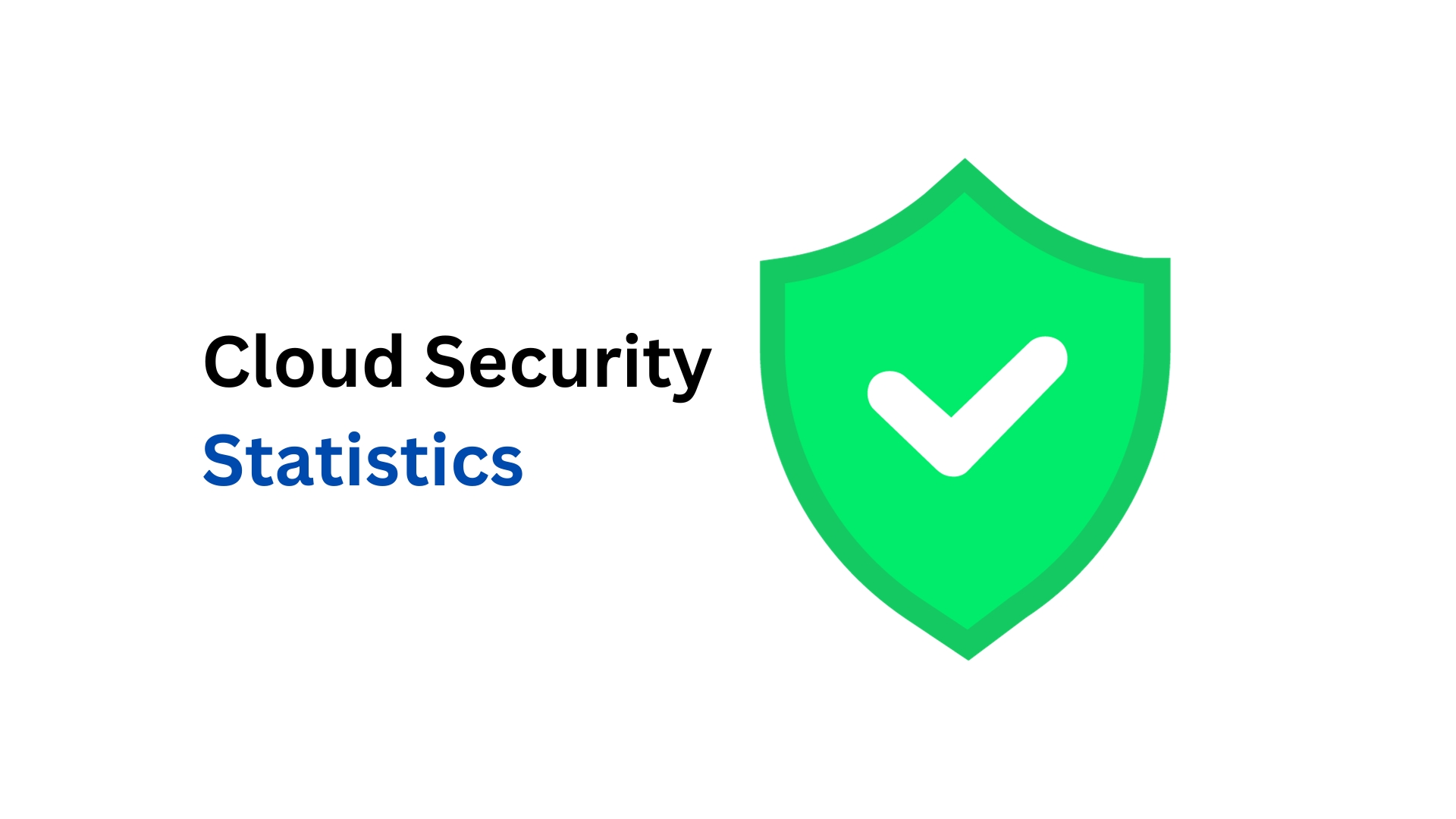
Page Contents
Introduction
Cloud Security Statistics: Cloud computing can bring many benefits to companies. However, they are also susceptible to being ruined because of the inability to ensure the proper security of information and privacy protections when using cloud computing. This in turn results in higher costs and potential losses to businesses. We will explore more details regarding Cloud Security Statistics in this report.
Cloud adoption has risen dramatically over the last few years. Although many organizations were already in the cloud the COVID-19 outbreak has helped accelerate this transition. With the widespread use of remote work, organizations are required to provide support and essential services to their remote workforce.
In the end, more than 90% of companies employ some form of cloud-based infrastructure. In addition, more than three-quarters (76 percent) are using multi-cloud deployments made up of at least two cloud service providers. These cloud environments host crucial applications for business and also protect sensitive customer and company information.
With the shift to cloud computing comes an increased necessity to collect Cloud Security Statistics. Cloud-hosted applications need to be secured against attacks and cloud-hosted information must be secured against unauthorized access as per the applicable laws. Cloud environments are in a significant way from the on-prem infrastructure this means that the traditional security tools and methods don't always work when working in the cloud. In the end, many companies are confronted with major issues when it comes to securing their cloud-based infrastructure.
Editor’s Choice
- 60% of global corporate data are stored on the cloud.
- 94% of businesses globally use one or more cloud computing services.
- It is estimated that the global Cloud Security Statistics market is projected to expand from $480 billion in 2022 to $2.297 trillion by 2032.
- With 32 percent, Amazon AWS owns the largest market share in cloud computing.
- 39% of businesses said they've been the victim of data breaches in their cloud environments.
- The amount of public money spent on cloud computing services is forecast to hit $597.3 billion by 2023. This will increase by 21.7 percent.
- 92% of companies have embraced a multi-cloud strategy.
- The market for cloud-based technology is predicted to reach $ 864 billion in 2025. It is expected to grow at an annual rate of 12.8 percent per year.
- Global storage of data will be greater than 200 Zettabytes of data by 2025.
- In 2025, more than 100 zettabytes of data are expected to remain in cloud storage. (Cloudwards)
- 89% of businesses have a multi-cloud strategy. (Flexera)
- 71 percent of Americans use cloud storage such as Dropbox as well as iCloud. (Statista)
- 48% of data from companies is stored in the cloud. (Panda Security)
- The market for cloud computing by 2020 is $371.4 billion. (Globe Newswire)
- Spending by end-users worldwide on public cloud services is expected to increase by 23.1 percent in 2021. (Gartner)
- With 83% of cloud users, security is the most frequent issue in cloud adoption. (Cloudwards)
- 52% of businesses want cloud-based solutions that include security tools. (Cloudwards)
Financial Resilience Statistics
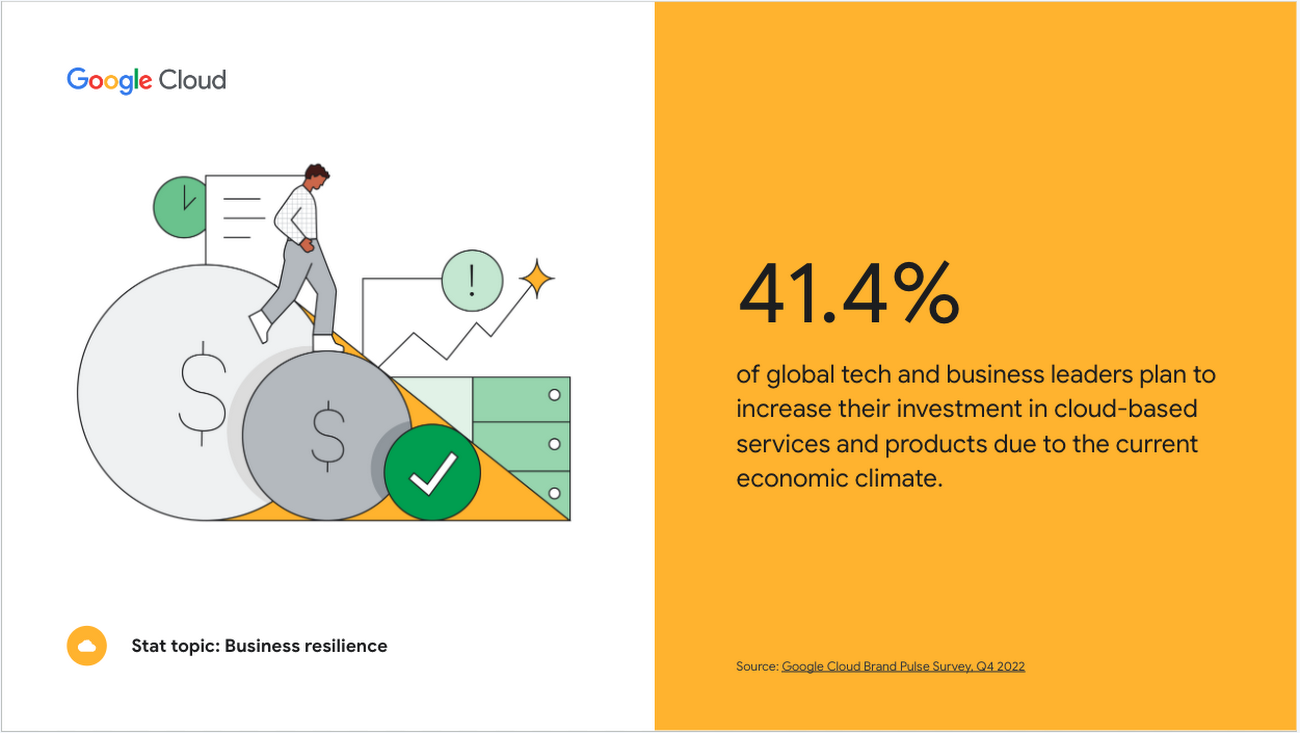
(Source: cloud.google.com)
- IT executives are relying on the cloud to help them prepare for whatever is to come.
Given the current macroeconomic environment cloud experts say they are expanding their usage of cloud-based services and products (41.4 percent) They are also planning to migrate from old software for enterprise to cloud-based solutions (33.4 percent) and moving workloads on-premises to cloud computing (32.8 32.8 %).
- Cloud decision-makers are prioritizing staffing in the context of the cost of cloud services.
Over half of businesses have either hired new employees or re-training staff to optimize their cloud spending.
- Businesses of all industries can benefit from cloud computing.
A thorough examination of cloud cost optimization tools and value-oriented business scenarios predicts that there will be over $1 trillion of run-rate EBITDA over Fortune 500 companies up to grabs by 2030.
- The majority of companies have not yet adopted cloud FinOps.
In a survey in 2022 conducted by cloud FinOps practitioners, 37.1% of the 572 participants who answered an assessment of the maturity of their cloud FinOps initiatives said that they were at the “crawl” stage in which they were getting the foundations put in place. A further 41.7 percent had reached”‘the “walk” phase, which is where practitioners have established procedures but haven't yet mastered them however only 19.5 percent of the respondents were on the cutting edge of maturity when cloud FinOps is considered to be business as usual (the “run” level). The remaining respondents were the “pre-crawl” portion.
- “Industry cloud technology” can increase the agility of organizations accelerate innovation, speed up innovation, and increase time to value.
By 2027, over 50% of companies will be using cloud platforms used by the industry to speed up their business plans. Cloud platforms for industry enable the shift away from generic platforms to ones specifically designed to meet the requirements of the industry that users are in.
- Cloud cost optimization practices can cut down on time and unnecessary expenditure.
Over 40% of tech and professionals in the business sector use automated policies to stop work after hours and make sure that underutilized instances are properly sized. The automated cloud optimization rules will reduce time while ensuring companies monitor their environment consistently to avoid unnecessary waste.
- When it comes to choosing a trusted cloud computing service provider the decision-makers are searching for three key qualities.
The majority (54 percent) of business and tech leaders would like cloud service providers who assist them in identifying ways to improve their revenue or cut expenses. Furthermore, 50% of them define”a “strategic partnership” as a partner who “understands the direction my industry is heading and can provide solutions for my future requirements” as well as 50% state it's “having a service provider that assists me in implementing and maintaining my technology infrastructure.”
Driving Factors
More widespread adoption of Cloud Computing Solutions and Services to Enhance Market Growth
One of the main reasons behind the Cloud Security Statistics market growth is the growing use of cloud computing. Security solutions for cyber security are based on sophisticated mathematical forecast models that monitor massive amounts of data and structured data. Cloud technology can provide this monitoring within a secure and safe environment.
Major players like Cisco Systems, IBM Corporation, and many others are committed to implementing cloud computing into the field of cyber-security solutions. These cloud computing services are based on ‘analytics-as-a-service (AaaS) offerings, assisting end users to quickly track and control uncertain threats. Additionally, the growth of these services is encouraged by the rising need for huge storage solutions to protect and store information using sophisticated security techniques.
Additionally, major firms are also adopting cloud-based security services. This will help companies in providing complete rights to use private information throughout the international operation to their employees. For example, in December of this year, Fortinet, Inc. amalgamation permitted its users to use cloud platforms to provide advanced security for their employees as well as computing applications. This growing adoption is likely to grow the market size.
Restrictive Factors
Budget and data privacy are significant market barriers
As the world becomes increasingly aware of advanced security threats as well as smaller tools for attack The need for more sophisticated IT/network security solutions that can tackle these threats is growing exponentially. Traditional security solutions used by organizations can't defend enterprises against cloud, and network security threats and endpoints.
A large amount of money is required to enable security firms to create modern, technologically advanced counterparts. The high price of such solutions restricts their use by companies, especially SMEs to a large degree. Additionally, the capital expense of security solutions providers rises because the R&D team grows. Other highlighted challenges of the market include data loss/leakage, data privacy/confidentially, and unauthorized access to security platforms.
Latest Development Statistics
The global cloud computing market is expected to witness a compound annual growth rate of 14.1% from 2023 to 2030, reaching $1,554.94 billion by 2030.
Cloud computing will not only be a technological approach for delivering applications. It will also serve as the critical driver of business innovation.
Read on to find out more about the future of cloud computing statistics.
- Between 2022 and 2032 the cloud computing market will reach $1.949 billion.
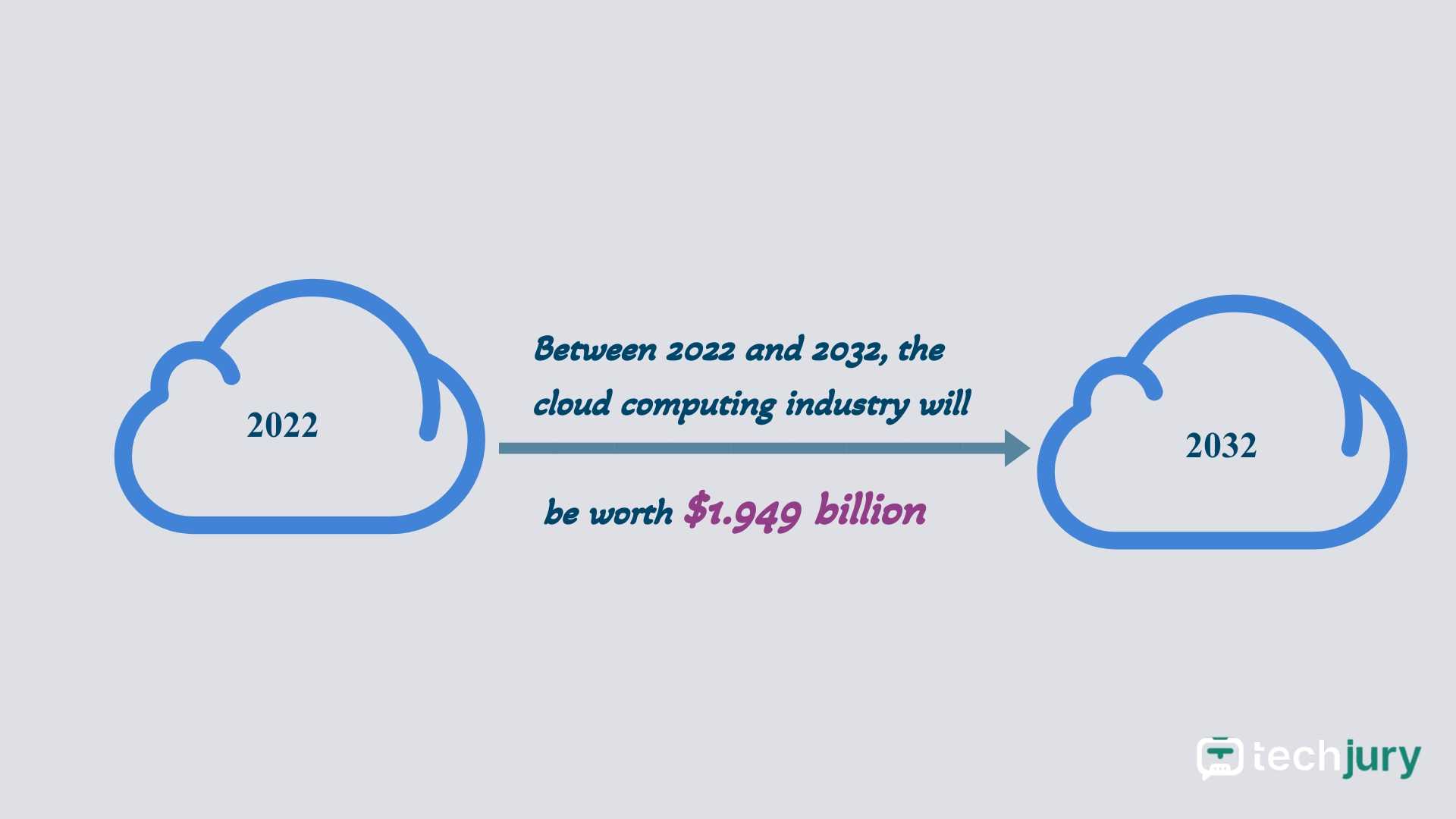
(Source: techjury.net)
The industry is expected to grow at a CAGR of 15% over the forecast time. This means it will reach $1.949 billion from 2022 until 2032. Experts believe that the growth is due to the rapid transition towards digital workplaces.
- Companies will create 95% of digital work in cloud-based environments by 2025.
95% of digital workers expect to have cloud architecture concepts and capabilities in 2025. This will increase by 65% compared to 2021. About 86.5 percent of companies have at least one cloud that is private at the same time, and 40% of the workloads combine hybrid and private cloud.
- The median wage of cloud-based professionals in the US is $118,449 in May 2023.
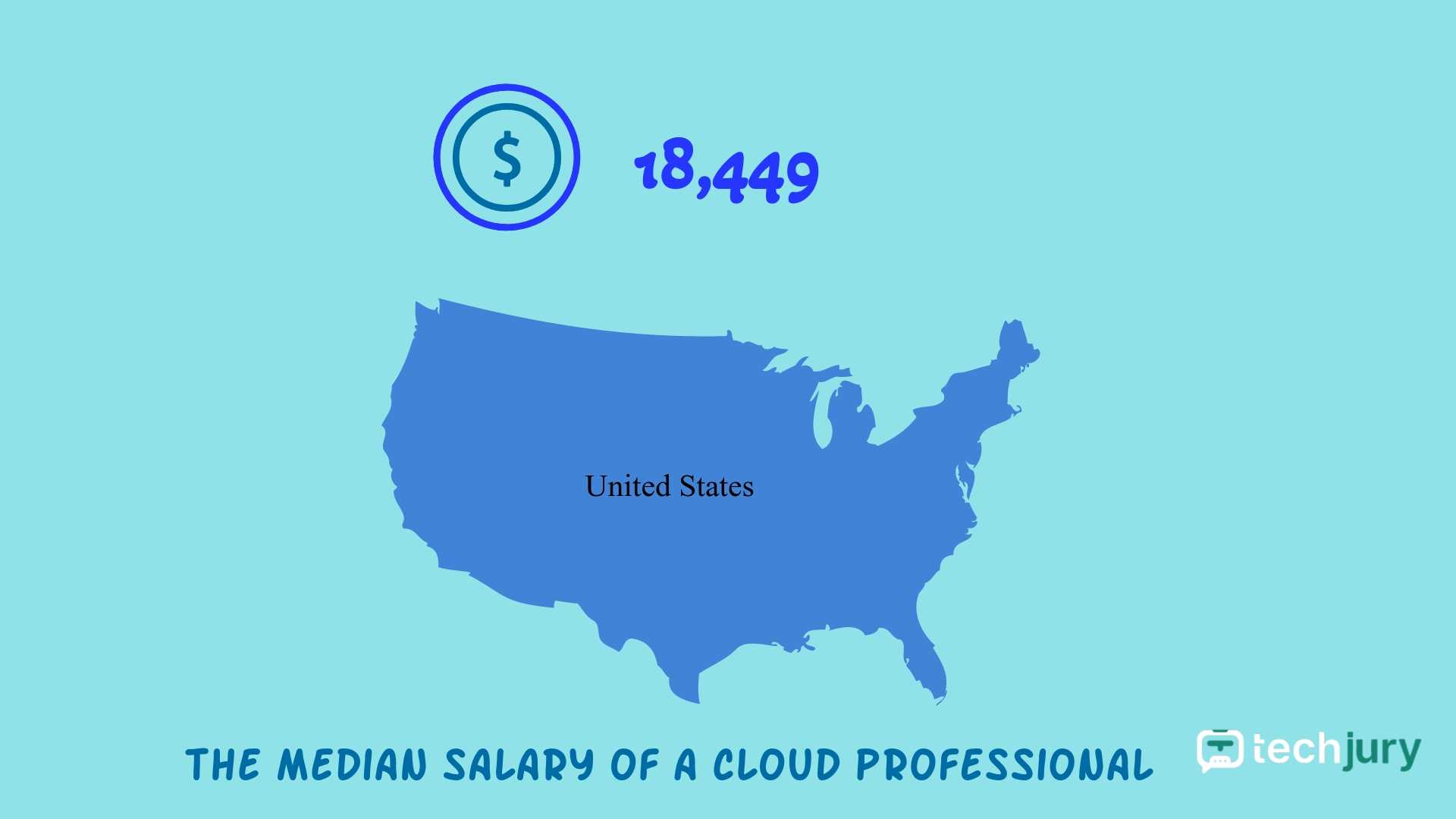
(Source: techjury.net)
The study covered more than fifty thousand job advertisements within the field of cloud technology. It revealed that the average wage for highly skilled professionals was an astonishing increase of $22,050 from 2016. Cloud experts are in high demand today. is greater than ever before and is evident in their pay.
- By 2025, nearly half of all cloud-related investment will go to four major categories of enterprise.
A study on cloud computing by Gartner revealed that enterprises will dedicate more than 51% of their budgets to changing four areas in 2025. That's one-tenth of the expenditure in 2022. The categories are:
- Business process services
- Software for the infrastructure
- Infrastructure for the system
- Software for application
- The market for cloud monitoring will expand by 22.7 percent between 2020 and 2022.
The market for cloud monitoring was estimated at $1.86 billion as of 2022. It is predicted to grow to $2.19 billion at the end of 2023 and reach $9.96 billion by 2030, showing an increase of 24.1% during the forecasted time.
With the speedy transition to cloud computing due to its versatility, there will be the need to integrate systems to control it. This means that companies will need to pay more to use the capabilities.
- The cost of cloud infrastructure services surpassed $30 billion in Q2 of 2020.
According to the most up-to-date statistics and data on cloud computing, the total expenditure on cloud-based services reached $30 billion during the second quarter. This represents a $7.5 billion increase over Q2 of last year. This increase is a torch that has been awaited by years of constant growth. Between 2016 to 2017 there was an increase of $3.3 billion. From then on, gains have been much more dramatic and have increased by an additional billion per YoY increment.
- 74 percent of chief financial officers believe cloud computing had the most significant impact on their businesses in 2017.
Forbes stated that over 70% of the CFOs stated cloud computing technology had a significant impact on their businesses in 2017. Cloud computing integration networks enabled cloud computing platforms to collaborate more widely. Cloud computing data for 2017 suggested that cloud computing would see a higher level of utilization and higher profits.
COVID-19 Impact
The COVID-19 epidemic has had a profound impact on the market for cloud security due to the dramatic increase in remote work or online-based activities. As more and more people work from home arrangements, companies were forced to adopt cloud-based applications and services to guarantee business continuity quickly. However, it also exposed the weaknesses and problems with cloud-based security. Schools had to contend with cybersecurity issues when they switched to distance education, which made them vulnerable to security breaches. The number of social engineering attacks grew by sabotaging the fear of people and their dependence on information stored online. Small and medium-sized companies with financial limitations found it difficult to prioritize cloud security.
Furthermore, the rush to create apps for tracking contact and remote healthcare solutions has led to security flaws, which made these platforms vulnerable to cyberattacks. Cloud-based video platforms for entertainment and conferencing saw huge growth in demand, and require strong security measures and encryption.
As it was true that the Cloud Security Statistics market experienced an increase in demand due to the growing need for collaboration services and compliance issues, businesses rushed to adopt cloud services without changing their accounting practices to comply with the requirements of regulatory agencies.
The adoption of cloud services grew rapidly as cloud adoption grew, and the visibility and complexity issues were heightened, making it easier for cybercriminals to take advantage of remote workers. Despite these issues however, the market for cloud security has also seen opportunities for growth due to the need for improved security, encryption, and authentication as well as secure cloud services to tackle the increasing cybersecurity risks of the pandemic period.
Cloud Computing Market Size Statistics
- A global Cloud Security Statistics market was estimated at $546.1 billion in 2022.
- With the highest revenue share of 41.2 percent, North America emerged as the leading market, confirming its importance and strategic advantages in defining the world of cloud computing.
- North America is expected to dominate the revenue market between 2023 and 2030. This is due to its early adoption of technologies such as AI robotics IoT as well and the cloud.
- The presence of major cloud providers such as IBM, Microsoft, and Oracle corporations is a major driver of the adoption of cloud services in the region.
- The telecommunications and IT industries have become major players that hold the most market share of cloud computing in the world.
- But, the healthcare industry is expected to see the greatest compound annual rate of growth.
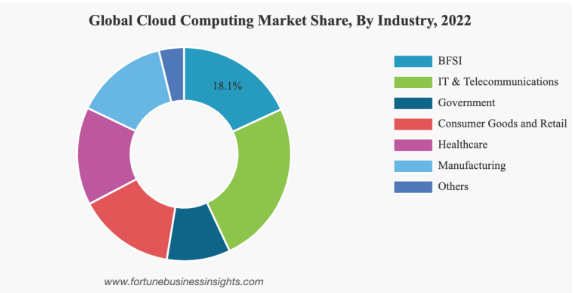
(Source: techopedia.com)
- In addition, cloud security statistics The Cloud Security Statistics computing market has transformed the world of video games, with the introduction of cloud gaming as an integral feature.
- Amazon Web Services, Inc. invested 35 billion dollars in cloud computing data centers in Virginia from 2011 to 2020 to help with the development of cloud gaming.
- At the end of 2021, the estimated number of cloud gaming users would be 23.7 million players who paid for cloud gaming services and spent the sum of $1.6 billion on streaming and cloud gaming games.
- About 94% of people familiar with cloud gaming either tried it out (50%) or expressed curiosity about trying it (44%).
The most well-known cloud gaming services of 2023 are:
- Xbox Cloud Gaming
- PlayStation Now
- GeForce Now
- Amazon Luna
Top Cloud Countries
- In 2019 China has been estimated to have spent about $13 billion in cloud computing services that are public which is the highest cloud service provider in the Asia-Pacific region. (Enterprise Creation Network, 2019)
- The 2021 Chinese cloud-based services market is expected to be worth around 11 billion yuan, which is $17.09 billion. (Enterprise Creation Network, 2019)
- In addition, there is a huge increase in there is a growing demand for the UK cloud-based market SaaS is the largest segment, with $9.9 billion in revenue by 2020. PaaS is responsible for 20% of the market and IaaS for 13 percent. (Statista, 2021)
- In a survey conducted in December about 36% of businesses in Japan said that all of departments have already moved into the cloud. However, 7% aren't aware of the nature of the cloud. (MIAC-Japan, 2019)
- In Germany, cloud-related spending was estimated to be higher than $8 billion by 2020. (BuddeComm, 2020)
- As both public and private organizations shift to cloud computing as they move to the cloud, new trends in SaaS indicate that this rapidly expanding segment will likely offer the most innovative and disruptive technology shortly.
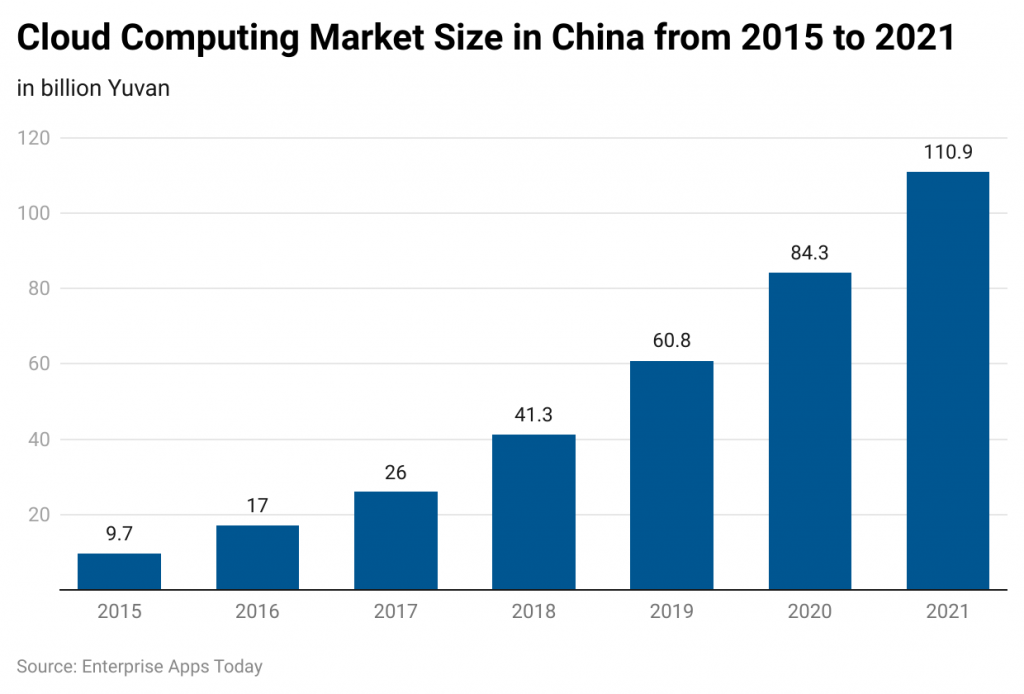
(Reference: financesonline.com)
Milestones Within Cloud Computing Statistics
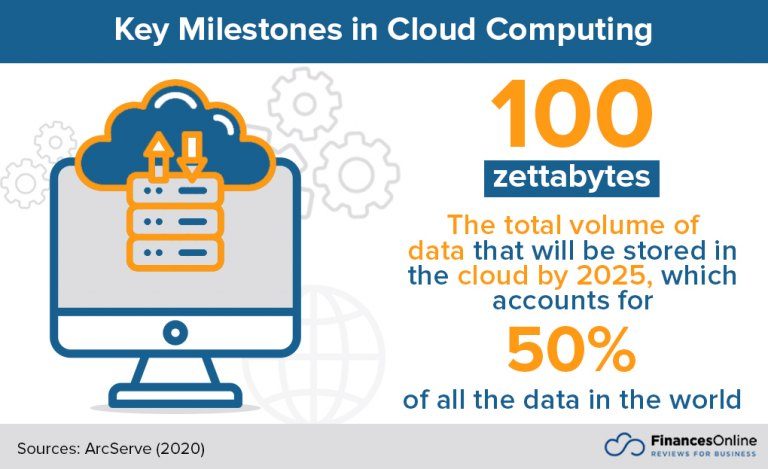
(Source: financesonline.com)
- It is one of the largest technological markets around the globe at present, it's worth knowing some of the pivotal moments within the development of cloud computing.
- The first precedent to what we call the cloud today was J.C.R. Licklider's idea for the concept of an “intergalactic computing network” during the 60s. (Internet Society, 2021)
- In 1999 Salesforce.com (initially, “Force.com”) was created as the first SaaS offering, which entails that business applications are delivered through the cloud. (Salesforce, 2019)
- The next significant development in the history of the cloud was the launch 2006 of Amazon Web Services in 2006. (Marks, 2018)
- It was in 2008 that Microsoft declared that it was joining the booming cloud market. The announcement was finally implemented in 2010 when it unveiled its Azure platform. (Kommalapati, 2010)
- In 2009 IBM's LotusLive was introduced, which was later renamed IBM SmartCloud. The same year, IBM also launched its first IaaS called the IBM Smart Business Storage Cloud. (Boulton, 2009)
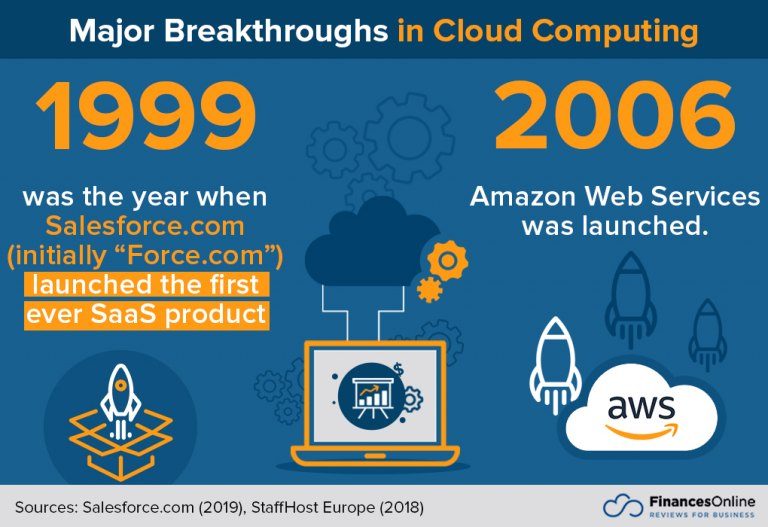
(Source: financesonline.com)
- OnLive began as the initial major cloud gaming platform. The service was first launched in June. (Biggs, 2010)
- In 2012., Google was the first company to join in on cloud computing via its Google Compute Engine which was released in 2013 and became an element of the Google Cloud Platform. (Lawler, 2012)
- In 2018 there was a rise in business applications that went cloud-native. (Bartoletti, 2019)
- In the year 2019, experts predicted that 2020 would be the year that enterprise applications will be moved to cloud computing (Bartoletti 2019, 2019). The pandemic, although not expected was the driving force behind this move.
- Based on the 2020 Data Attack Surface Report, the amount of data that will remain in cloud storage will be 100 zettabytes or 50% of all data stored in the world by 2025. (Morgan, 2020)
- 2023 will be a significant event for the world market for games. In the year 2023, the player count will be above the mark of three billion, which is an annual growth rate (2015-2023) that is +5.6 percent. (Wijman, 2020)
Conclusion
As we continue to increasingly rely on cloud computing it is vital to keep up-to-date with cloud security data. When we are aware of the latest developments, we not only increase our awareness but also help us implement the most effective security procedures. Business's future is dependent on the security and integrity of our data. cloud security plays a crucial role in ensuring this.
We hope Cloud Security Statistics will provide valuable information about the situation of cloud security and will inspire you to take more steps and take advantage of the most efficient solutions cloud security providers have to provide. Keep in mind that by focusing on cybersecurity and data protection working together, we can all work towards a future where cloud technology can take our technology to new levels while not risking our security.
Sources
FAQ.
The following stats show the most pressing concerns around cloud security according to cyber security experts. 52% of cybersecurity experts mention insecure APIs as a crucial cloud security concern. 68% of the responding cyber security experts categorize misconfigured cloud infrastructure as a pressing concern.
45% of breaches are cloud-based. According to a recent survey, 80% of companies have experienced at least one cloud security incident in the last year, and 27% of organizations have experienced a public cloud security incident—up 10% from last year.
Security: Cloud storage often offers greater protection against cyberattacks than other options because it's backed up regularly and stored off-site. It's also monitored for suspicious activity 24/7.
Cloud security monitoring encompasses several processes that allow organizations to review, manage, and observe operational workflows in a cloud environment. Cloud security monitoring combines manual and automated processes to track and assess the security of servers, applications, software platforms, and websites.
Human error: From using weak passwords to falling victim to phishing scams, human error is a common issue that puts cloud security systems at risk. Statistics show that 88% of cloud-based data breaches are attributed to human error.
Private and on-premises clouds are more difficult to hack—but that also means that any security failures are your responsibility. In a public cloud, security responsibilities are shared between the service provider and the customer.
You need a secure way to immediately access your data. Cloud security ensures your data and applications are readily available to authorized users. You'll always have a reliable method to access your cloud applications and information, helping you quickly take action on any potential security issues.

Barry is a lover of everything technology. Figuring out how the software works and creating content to shed more light on the value it offers users is his favorite pastime. When not evaluating apps or programs, he's busy trying out new healthy recipes, doing yoga, meditating, or taking nature walks with his little one.